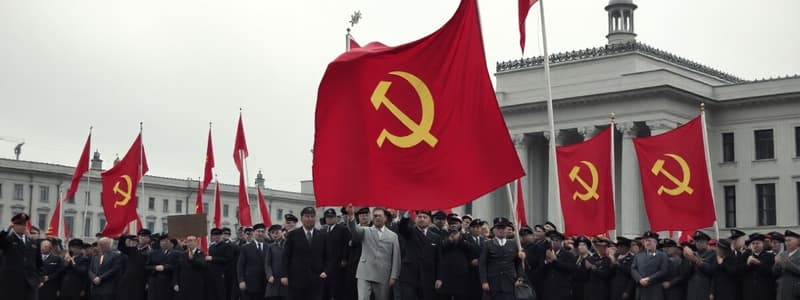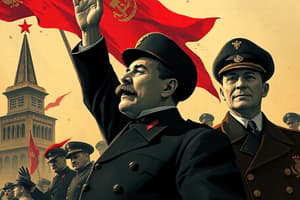Podcast
Questions and Answers
What was Stalin's pragmatic view regarding socialism?
What was Stalin's pragmatic view regarding socialism?
- Only international revolutions can succeed.
- Every country should focus on a permanent revolution.
- Socialism in one country is possible. (correct)
- Socialism is doomed to fail in one country.
Trotsky was present at Lenin's funeral.
Trotsky was present at Lenin's funeral.
False (B)
Who were the main opponents of Stalin in the leadership struggle?
Who were the main opponents of Stalin in the leadership struggle?
Trotsky, Kamenev, and Zinoviev
Stalin's role as ____________ gave him significant control over the Party's bureaucracy.
Stalin's role as ____________ gave him significant control over the Party's bureaucracy.
Which policy did Stalin initially oscillate between before committing to rapid industrialization?
Which policy did Stalin initially oscillate between before committing to rapid industrialization?
Match the following individuals with their relationships to Stalin:
Match the following individuals with their relationships to Stalin:
The Ban on Factionalism was created by Trotsky to strengthen his own position.
The Ban on Factionalism was created by Trotsky to strengthen his own position.
What significant event in 1924 helped Stalin entrench his position in the Party?
What significant event in 1924 helped Stalin entrench his position in the Party?
What was the primary partnership that governed the country from 1926 to 1927?
What was the primary partnership that governed the country from 1926 to 1927?
Trotsky was expelled from the party by the Central Committee in October 1927.
Trotsky was expelled from the party by the Central Committee in October 1927.
What form of government did Stalin emphasize through his role as General Secretary?
What form of government did Stalin emphasize through his role as General Secretary?
Stalin's government used fear as a driving force for the imposition of ________ and extensive use of secret police.
Stalin's government used fear as a driving force for the imposition of ________ and extensive use of secret police.
Which political group did Stalin support in China?
Which political group did Stalin support in China?
The Soviet Union maintained a strict non-aggression pact with Germany through the Treaty of Berlin.
The Soviet Union maintained a strict non-aggression pact with Germany through the Treaty of Berlin.
What was the major economic policy adopted by Stalin that aimed to increase agricultural productivity?
What was the major economic policy adopted by Stalin that aimed to increase agricultural productivity?
The 'Great Turn' refers to the shift in ________ policies under Stalin.
The 'Great Turn' refers to the shift in ________ policies under Stalin.
Match each event with its corresponding date:
Match each event with its corresponding date:
What was one criticism leveled at Stalin regarding his support for the Guomindang?
What was one criticism leveled at Stalin regarding his support for the Guomindang?
Bukharin was striped of several governmental positions and subsequently expelled from the Politburo in late 1929.
Bukharin was striped of several governmental positions and subsequently expelled from the Politburo in late 1929.
What was the name of the ideological debate within the party during the 1920s?
What was the name of the ideological debate within the party during the 1920s?
Stalin deployed severe measures against the ________ during the food shortage of 1928.
Stalin deployed severe measures against the ________ during the food shortage of 1928.
What prominent phrase was associated with Stalin to emphasize his leadership?
What prominent phrase was associated with Stalin to emphasize his leadership?
Flashcards
Permanent Revolution
Permanent Revolution
A concept advocating for continuous worldwide revolution rather than socialism in a single country.
Socialism in One Country
Socialism in One Country
Stalin's belief that socialism could be achieved in Bolshevik Russia without global revolution.
New Economic Policy (NEP)
New Economic Policy (NEP)
A temporary economic policy instituted by Lenin allowing some private enterprise to rebuild the economy.
Triumvirate
Triumvirate
Signup and view all the flashcards
Role of General Secretary
Role of General Secretary
Signup and view all the flashcards
Left Opposition
Left Opposition
Signup and view all the flashcards
Comintern
Comintern
Signup and view all the flashcards
Cult of Leninism
Cult of Leninism
Signup and view all the flashcards
Fourteenth Party Congress
Fourteenth Party Congress
Signup and view all the flashcards
Left (United) Opposition
Left (United) Opposition
Signup and view all the flashcards
Duumvirate
Duumvirate
Signup and view all the flashcards
Literary Discussion
Literary Discussion
Signup and view all the flashcards
Expulsion of Trotsky
Expulsion of Trotsky
Signup and view all the flashcards
Right Opposition
Right Opposition
Signup and view all the flashcards
NEP dissatisfaction
NEP dissatisfaction
Signup and view all the flashcards
Stalin's measures against peasants
Stalin's measures against peasants
Signup and view all the flashcards
Cult of Personality
Cult of Personality
Signup and view all the flashcards
Stalin's foreign policy
Stalin's foreign policy
Signup and view all the flashcards
Treaty of Berlin
Treaty of Berlin
Signup and view all the flashcards
Comintern prioritization
Comintern prioritization
Signup and view all the flashcards
Great Turn
Great Turn
Signup and view all the flashcards
First Five-Year Plan
First Five-Year Plan
Signup and view all the flashcards
Collectivisation
Collectivisation
Signup and view all the flashcards
Study Notes
Stalin's Rise to Power (1924-1929)
-
Ideological Debates: Disagreements centered around the viability of "Socialism in One Country" versus "Permanent Revolution." Stalin pragmatically advocated for developing socialism within Russia, while Trotsky favored global revolution. There were also debates about the New Economic Policy (NEP) versus rapid industrialization, with Stalin's stance shifting.
-
Stalin's Position in 1924: Stalin leveraged Lenin's funeral to enhance his position within the Party leadership, promoting the cult of Leninism. His political skills were underestimated by others. His role as General Secretary gave him control over Party bureaucracy.
-
Defeat of the Left Opposition (1924-1927): Trotsky's hesitation to directly challenge Stalin, coupled with Stalin's alliances and support from Congress, allowed him to gain a stronger position. Stalin cultivated loyal support within the Party. The Left Opposition's later united effort against Stalin failed.
-
Defeat of Bukharin and the Right (1928-1929): Food shortages in the country and Stalin's harsh policies towards the peasantry led to tensions with Bukharin. Stalin's unilateral actions and increasing radical policies solidified his stance against Bukharin who was then sidelined.
Consolidation of Stalin's Power
-
Government & Propaganda: Stalin's government presented itself as an extension of Lenin's legacy, using bureaucratic centralism and suppression of dissent. Divide and rule was used to consolidate power by building support through loyal followers. Propaganda portrayed Stalin as a visionary leader ("the Lenin of Today").
-
Stalin's Foreign Policy – China: Initially, Stalin sided with Chiang Kai-shek (GMD) to maintain stability on Russia's borders. His alliance with GMD led to the massacre of communist workers, a controversial move which was criticised.
-
Stalin's Foreign Policy – Germany: Russia maintained diplomatic relations with Germany through the Treaty of Berlin (which addressed mutual neutrality if attacked by a third party) as part of a broader strategy to stabilize relations. The USSR received financial assistance from German Banks.
-
Changes in the Comintern: Stalin, tightening his grip, instigated a more aggressive Comintern targeting anti-communist, democratic parties ("social fascists") representing a shift from prioritizing domestic stability to attacking external enemies.
The "Great Turn" (1928-1929)
- Economic Shift: The shift towards rapid industrialization and collectivization of agriculture marked a radical departure from the NEP. This created significant economic and social disruptions in the country.
Studying That Suits You
Use AI to generate personalized quizzes and flashcards to suit your learning preferences.




